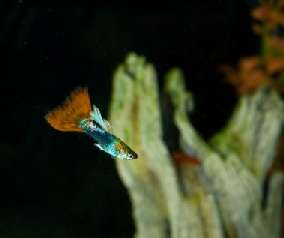Guppies

Guppies (Poecilia reticulata) are beautiful fish that are easy to keep in an aquarium. The male guppy shows considerable variation in color and pattern, whereas the female guppy is not nearly so colorful. Some females have been bred to show some color, especially in the tail, but they are never as colorful as the male guppy, as you can see in the photo above. The females are the mostly colorless fish.
While wild male guppies (guppies are originally from Central America) are colorful, they are not as colorful as what you typically see in an aquarium or a pet store. Male guppies have been bred to have the fancy tails, large dorsal fins, and to show the brilliant colors that you now typically see. There are several guppy societies devoted to breeding show guppies and some of these guppies are quite expensive. The guppies that you will find in your pet store, although still very pretty, are generally not expensive however.
Guppies readily eat dried food, such as dried tropical flakes, and they will also eat insects, tubifex worms, bloodworms, small crustaceans, such as brine shrimp, and plant matter.
Guppies can be kept in a community tank, although it is best not to keep them with aggressive fish. It is best not to keep them with large fish. I've seen large angelfish swallow adult male guppies whole, however, they can be kept with smaller angelfish.
Guppies prefer neutral (pH of 7.0) to slightly alkaline water and the water temperature should be between 72-83 degrees Fahrenheit or 22-28 degrees Celsius.
Guppy Reproduction
Adult male guppies reach a size of approximately 1.2 inches and adult female guppies reach a size of about 2.4-2.5 inches. It is best to keep at least 2-3 females per each male because male guppies often harass the females. Plants are also good so that the female has plenty of hiding spaces.

Guppies are about the easiest fish to breed in the aquarium. Guppies engage in internal fertilization. The anal fin of the male is modified into a gonopodium and the male uses this to inseminate the female. Female guppies can store sperm for several months and can produce several broods without further fertilization.
You will know when your female guppy is pregnant because the dark gravid spot on her abdomen will become larger and she will also get fatter. Guppies are livebearing fish and the fry emerge from the female fully developed in about 4-6 weeks. Adult guppies will eat their fry and so the fry must be separated from adult guppies until they are larger. Sometimes plants will camouflage baby fish, but I've often found that it is safer to keep them separate from their parents.
The fry are born colorless and won't start getting their color for a few weeks. You'll begin to see a small gravid spot on the females in 2-3 weeks.
To help keep the fry safe, I've had good luck using a breeding trap. You can buy these relatively cheaply at most pet stores. They are plastic containers that you put the pregnant female guppy in (or any livebearing fish). The breeding trap floats in the aquarium. There are two compartments. The top compartment houses the pregnant female guppy. There is a small space between the top and bottom compartment so that that the fry will drop through to the bottom compartment. It is possible for the fry to swim back through this space into the top compartment, but they usually don't. After the female has finished giving birth to the fry you should remove her from the trap and place her back in the aquarium. The plastic piece that separates her from the fry should be removed and you can raise the fry for a short time in the trap. However, the water in the trap tends to get somewhat stagnant and so this isn't an ideal place to raise the fry for long. If you do raise the fry in the trap you will need to clean out the trap and replace it with water from the aquarium on a regular basis.
Feeding the Fry
Baby guppies can be fed newly hatched brine shrimp, newly hatched daphnia, or they can be fed dry food. Several fish food companies make dried fry food for livebearing fish and you can find these online or at your pet store. I've successfully raised many baby guppies to adulthood using baby dried fish food, however, you are likely to get better growth of your guppy fry if you feed them live food as well as the dried food. Don't try to feed them adult flakes because these will be too large for their tiny mouths. Also see the article Feeding the Fry of Livebearing Fish.
